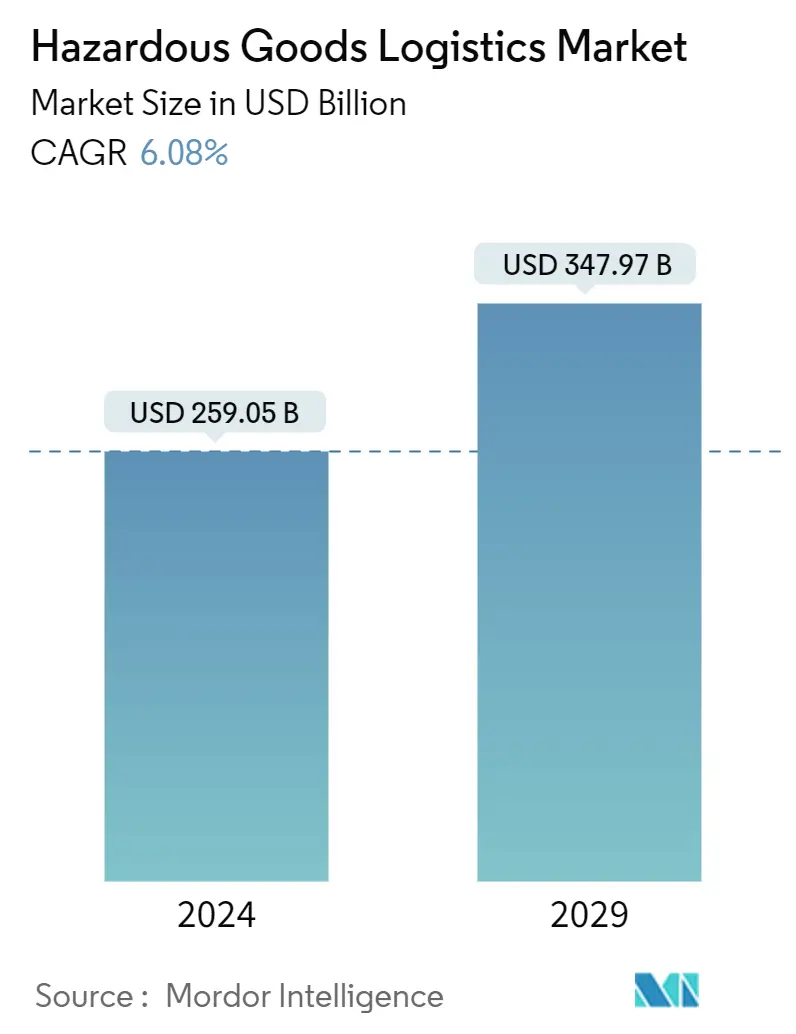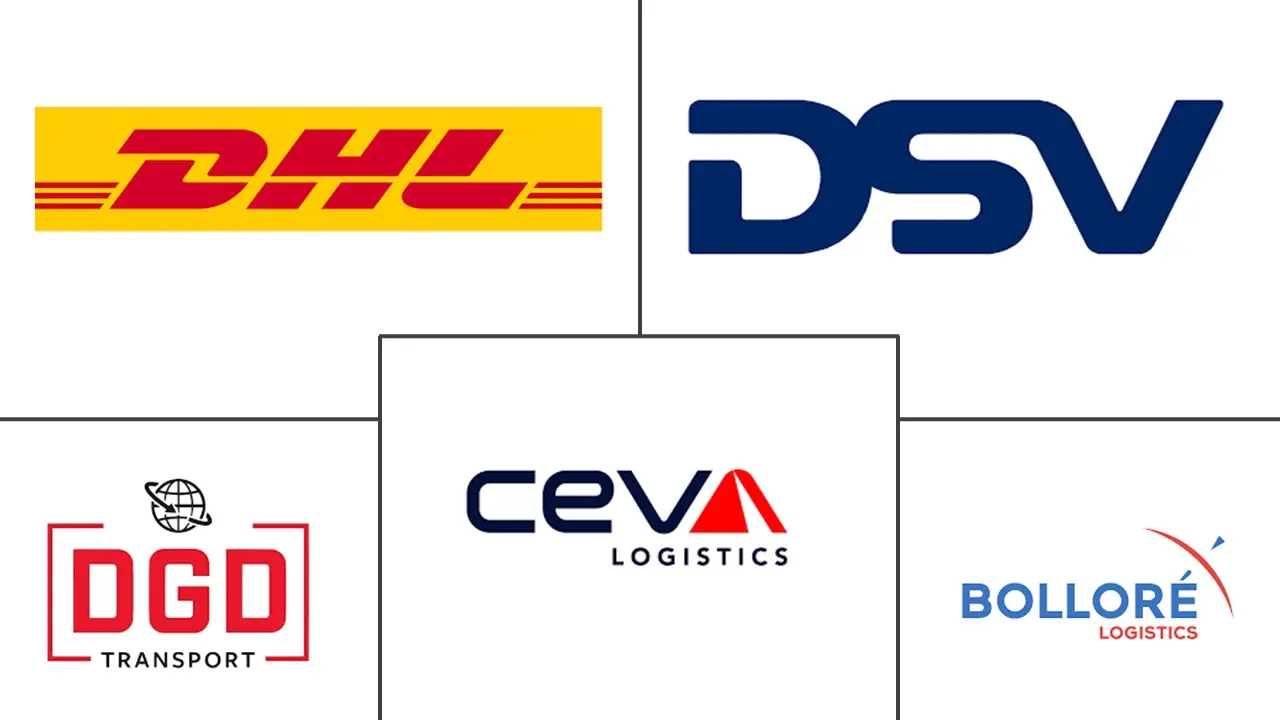Market Size of Hazardous Goods Logistics Industry

| Study Period | 2020 - 2029 |
| Market Size (2024) | USD 259.05 Billion |
| Market Size (2029) | USD 347.97 Billion |
| CAGR (2024 - 2029) | 6.08 % |
| Fastest Growing Market | Asia-Pacific |
| Largest Market | North America |
Major Players
*Disclaimer: Major Players sorted in no particular order |
Hazardous Goods Logistics Market Analysis
The Hazardous Goods Logistics Market size is estimated at USD 259.05 billion in 2024, and is expected to reach USD 347.97 billion by 2029, growing at a CAGR of 6.08% during the forecast period (2024-2029).
- Risky materials make up the bulk of international cargo, as they contain a wide range of commonly used products and items. A large portion of this cargo is said to be made up of petrol and petroleum products. Thanks to hydraulic fracturing and a government that has fostered a more conducive environment for fuel production, the current oil boom may be the result of unprecedented growth over the past few years. The United States currently produces the bulk of the world’s oil.
- The requirement to ship dangerous goods is anticipated to increase yearly, in addition to the numerous dangerous goods rules being updated annually. The need for UN packaging, training, labels, and placards will rise as a result of the growing requirement to move lithium batteries and the region's well-established gas and oil businesses, which are both driving the dangerous goods market to record highs.
- Deregulation of environmental regulations and the loosening of numerous rules restricting access to sensitive habitats and emissions has led to a boom in the oil and gas industry. Offshore drilling has also increased in our country. The US currently exports more gas than it imports, and production of gas is expected to grow in the coming year. The oil and gas market is expected to continue to grow as the US increases its external oil and gas exports.
- Additionally, all forms of transportation must be used to convey radioactive medication, virus samples, healthcare hazardous chemicals, and clinical waste such as surgical equipment. The oil and gas industry, for example, might have an impact on this expected expansion in the globe of dangerous goods. The oil and gas sector, which is still lucrative, is anticipated to receive investments totaling 237 billion dollars over the next ten years, or 25% of the entire estimated worldwide investment in this sector.
- The key to successfully transporting hazardous goods is digitization. A digital supply network serves as a technology platform for supply chain linkages and cross-business processes in transportation operations. It links suppliers, customers, shippers, and third-party logistics providers so they can work together more effectively and conduct business. Automated systems translate paper or email into the proper forms so that the document can be shared electronically with other people. This includes manual operations like completing a purchase order, recognizing the receipt of the order, and shipping confirmation.
- The lockdown during the COVID-19 pandemic created impediments to transporting chemicals and other dangerous goods, thereby hampering the growth of the hazardous goods logistics market. However, the demand from the pharmaceutical sector during COVID-19 had a positive impact on the market.
Hazardous Goods Logistics Industry Segmentation
Corrosive, flammable, explosive, spontaneously combustible, poisonous, oxidizing or water-reactive compounds are classified as hazardous goods. Logistics refers to the overall process of managing how resources are acquired, stored, and transported to their final destination.
The hazardous goods logistics market is segmented by service (transportation, warehousing and distribution, value-added services), by destination (domestic and international), and by geography (Asia-Pacific, North America, Europe, Latin America, Middle East, and Africa).
The report offers market size and forecasts for the hazardous goods logistics market in value (USD) for all the above segments.
| By Service | |
| Transportation | |
| Warehousing and Distribution | |
| Value-added Services |
| By Destination | |
| Domestic | |
| International |
Hazardous Goods Logistics Market Size Summary
The hazardous goods logistics market is poised for significant growth, driven by the increasing need to transport risky materials, which constitute a substantial portion of international cargo. This demand is largely fueled by the oil and gas industry, particularly in the United States, which leads global oil production. The market is also influenced by the rising transportation of lithium batteries and the ongoing expansion of gas and oil businesses. The deregulation of environmental policies has further bolstered the oil and gas sector, contributing to the market's expansion. Additionally, the logistics of hazardous goods encompass various sectors, including pharmaceuticals, nuclear power, and petrochemicals, necessitating stringent adherence to safety regulations and standards.
The market landscape is characterized by a mix of global and local players, with companies like DHL, DSV, Ceva Logistics, and Bollore Logistics leading the charge. These firms are leveraging technology and strategic partnerships to enhance their service offerings and meet the growing demands of hazardous goods transportation. The integration of digital supply networks is transforming logistics operations, facilitating better coordination among suppliers, customers, and logistics providers. Despite challenges posed by the COVID-19 pandemic, the market is expected to benefit from stricter government regulations and advancements in logistics technology, such as BlackBerry's asset tracking solutions and Drone Delivery Canada's drone delivery capabilities. These developments are set to enhance the safety and efficiency of transporting hazardous materials across various modes of transport.
Hazardous Goods Logistics Market Size - Table of Contents
-
1. MARKET INSIGHTS
-
1.1 Current Market Scenario
-
1.2 Industry Value Chain Analysis
-
1.3 Government Regulations and Initiatives
-
1.4 Brief on Dangerous Goods Classes
-
1.5 Review and Commentary on Goods Transport Regulations and Standards (Hazardous Materials Transportation Act (HMTA), International Air Transport Association Dangerous Goods Regulations (IATA DGR), etc.
-
1.6 Focus on Key Stakeholders in Supply Chain (Freight Forwarders, Ground Handling Agents, Carriers, Advisors and Consultants, etc.)
-
1.7 Key Information - Documentation, Special Permissions, and Safety Checklists
-
1.8 Spotlight - Equipment and Accessories Associated with Transport of Dangerous Goods (Air, Sea, and Road)
-
1.9 Potential Risk Involved in Shipment of Hazardous Materials
-
1.10 Insights on Packaging
-
1.11 Technology Snapshot (Digitalization and Process Optimization and Management Software, e-Dangerous Goods Declaration (eDGD), etc.)
-
1.12 Impact of COVID-19 and Geopolitical Events on the Market
-
-
2. MARKET SEGMENTATION
-
2.1 By Service
-
2.1.1 Transportation
-
2.1.2 Warehousing and Distribution
-
2.1.3 Value-added Services
-
-
2.2 By Destination
-
2.2.1 Domestic
-
2.2.2 International
-
-
Hazardous Goods Logistics Market Size FAQs
How big is the Hazardous Goods Logistics Market?
The Hazardous Goods Logistics Market size is expected to reach USD 259.05 billion in 2024 and grow at a CAGR of 6.08% to reach USD 347.97 billion by 2029.
What is the current Hazardous Goods Logistics Market size?
In 2024, the Hazardous Goods Logistics Market size is expected to reach USD 259.05 billion.

